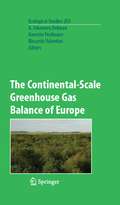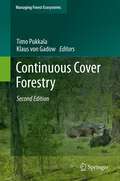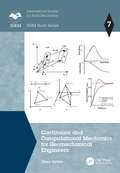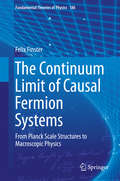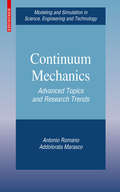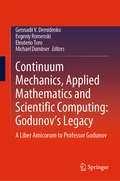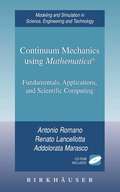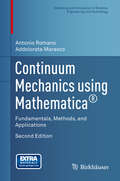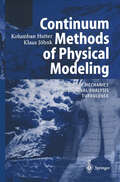- Table View
- List View
The Continental-Scale Greenhouse Gas Balance of Europe (Ecological Studies #203)
by Riccardo Valentini Han Dolman A. FreibauerThis book assesses the current greenhouse gas (GHG) monitoring capabilities of Europe, identifies and quantifies the uncertainties involved, and outlines the direction to a continental scale GHG monitoring network. The book uniquely addresses both the methodology of carbon cycle science and the science itself, providing a synthesis of carbon cycle science. The methods included provide the first comprehensive coverage of a full GHG accounting and monitoring system.
Continental Scientific Drilling: A Decade of Progress, and Challenges for the Future
by Ulrich Harms Christian Koeberl Mark D. ZobackThis volume provides a review and synthesizes the accomplishments of the past decade of the International Continental Scientific Drilling Program. More importantly, it defines opportunities for scientific advancement through future drilling projects addressing a broad range of disciplines in the Earth Sciences. In addition there is a review of all past projects that were supported by the ICDP, as well as of technical aspects associated with continental drilling.
Continental Shelf Limits: The Scientific and Legal Interface
by Peter J. Cook Chris M. CarletonArticle 76 of the United Nations Convention on the Law of the Sea lays down the rules and regulations governing claims to a continental shelf beyond 200 nautical miles for the 130 coastal States and entities that have ratified or acceded to it. This book is designed to help those coastal States implement the provisions of Article 76, covering the technical issues involved and explaining the interface between the legal concepts contained within the article. It covers all aspects that will have to be considered by a coastal State if it wishes to make a claim under the Convention, including the characteristics of continental margins, distance determination, bathymetric data collection. geological and geophysical techniques, and boundary conditions.
Continents and Supercontinents
by John J. Rogers M. SantoshTo this day, there is a great amount of controversy about where, when and how the so-called supercontinents--Pangea, Godwana, Rodinia, and Columbia--were made and broken. Continents and Supercontinents frames that controversy by giving all the necessary background on how continental crust is formed, modified, and destroyed, and what forces move plates. It also discusses how these processes affect the composition of seawater, climate, and the evolution of life. Rogers and Santosh begin with a survey of plate tectonics, and go on to describe the composition, production, and destruction of continental and oceanic crust, and show that cratons or assemblies of cratons became the first true continents, approximately one billion years after the earliest continental crust evolved. The middle part of the book concentrates on supercontinents, beginning with a discussion of types of orogenic belts, distinguishing those that formed by closure of an ocean basin within the belt and those that formed by intracontinental deformation caused by stresses generated elsewhere. This information permits discrimination between models of supercontinent formation by accretion of numerous small terranes and by reorganization of large old continental blocks. This background leads to a description of the assembly and fragmentation of supercontinents throughout earth history. The record is most difficult to interpret for the oldest supercontinent, Columbia, and also controversial for Rodinia, the next youngest supercontinent. The configurations and pattern of breakup of Gondwana and Pangea are well known, but some aspects of their assembly are unclear. The book also briefly describes the histories of continents after the breakup of Pangea, and discusses how changes in the composition of seawater, climate, and life may have been affected by the sizes and locations of continents and supercontinents.
Continua with Microstructure (Springer Tracts in Natural Philosophy #35)
by Gianfranco CaprizThis book proposes a new general setting for theories of bodies with microstructure when they are described within the scheme of the con tinuum: besides the usual fields of classical thermomechanics (dis placement, stress, temperature, etc.) some new fields enter the picture (order parameters, microstress, etc.). The book can be used in a semester course for students who have already followed lectures on the classical theory of continua and is intended as an introduction to special topics: materials with voids, liquid crystals, meromorphic con tinua. In fact, the content is essentially that of a series of lectures given in 1986 at the Scuola Estiva di Fisica Matematica in Ravello (Italy). I would like to thank the Scientific Committee of the Gruppo di Fisica Matematica of the Italian National Council of Research (CNR) for the invitation to teach in the School. I also thank the Committee for Mathematics of CNR and the National Science Foundation: they have supported my research over many years and given me the opportunity to study the topics presented in this book, in particular through a USA-Italy program initiated by Professor Clifford A. Truesdell. My interest in the field dates back to a period of collaboration with Paolo Podio-Guidugli and some of the basic ideas came up during our discussions.
Continuity and Change in the Tunisian Sahel
by Ray HarrisThe Tunisian Sahel is an extraordinary region for study. A unique and marginal zone in terms of its climate; its relationship to Europe and in its geo-political position as an Arab country in Africa, it provides a fascinating lens through which to study the complex geographical issues of continuity and change. Continuity and Change in the Tunisian Sahel explores just such issues using a number of sub-themes: Islam, the relationships the region has with the global economy, rural development, security, and urban form and function. Based on a well-established fieldwork course, and copiously illustrated with maps, diagrams, photographs, posters, quotations and tables, the book also includes practical advice on how to carry out fieldwork and field investigations in arid and semi-arid regions.
Continuity and Change in the Tunisian Sahel
by Ray HarrisThe Tunisian Sahel is an extraordinary region for study. A unique and marginal zone in terms of its climate; its relationship to Europe and in its geo-political position as an Arab country in Africa, it provides a fascinating lens through which to study the complex geographical issues of continuity and change. Continuity and Change in the Tunisian Sahel explores just such issues using a number of sub-themes: Islam, the relationships the region has with the global economy, rural development, security, and urban form and function. Based on a well-established fieldwork course, and copiously illustrated with maps, diagrams, photographs, posters, quotations and tables, the book also includes practical advice on how to carry out fieldwork and field investigations in arid and semi-arid regions.
Continuity, Integration and Fourier Theory (Universitext)
by Adriaan C. ZaanenThis book is a textbook for graduate or advanced undergraduate students in mathematics and (or) mathematical physics. It is not primarily aimed, therefore, at specialists (or those who wish to become specialists) in integra tion theory, Fourier theory and harmonic analysis, although even for these there might be some points of interest in the book (such as for example the simple remarks in Section 15). At many universities the students do not yet get acquainted with Lebesgue integration in their first and second year (or sometimes only with the first principles of integration on the real line ). The Lebesgue integral, however, is indispensable for obtaining a familiarity with Fourier series and Fourier transforms on a higher level; more so than by us ing only the Riemann integral. Therefore, we have included a discussion of integration theory - brief but with complete proofs - for Lebesgue measure in Euclidean space as well as for abstract measures. We give some emphasis to subjects of which an understanding is necessary for the Fourier theory in the later chapters. In view of the emphasis in modern mathematics curric ula on abstract subjects (algebraic geometry, algebraic topology, algebraic number theory) on the one hand and computer science on the other, it may be useful to have a textbook available (not too elementary and not too spe cialized) on the subjects - classical but still important to-day - which are mentioned in the title of this book.
Continuous and Discontinuous Modelling of Cohesive-Frictional Materials (Lecture Notes in Physics #568)
by P. A. Vermeer S. Diebels W. Ehlers H. J. Herrmann S. Luding E. RammA knowledge of the mechanical behaviour of both naturally occurring materials, such as soils and rocks, and artificial materials such as concrete and industrial granular matter, is of fundamental importance to their proper use in engineering and scientific applications. This volume contains selected lectures by international experts on current developments and problems in the numerical modelling of cohesive-frictional materials which provide a deeper understanding of the microscopic and macroscopic description of such materials. This book fills a gap by emphasizing the cross-fertilization of ideas between engineers and scientists engaged in this exciting field of research.
Continuous and Distributed Systems II: Theory and Applications (Studies in Systems, Decision and Control #30)
by Viktor A. Sadovnichiy Mikhail Z. ZgurovskyAs in the previous volume on the topic, the authors close the gap between abstract mathematical approaches, such as applied methods of modern algebra and analysis, fundamental and computational mechanics, nonautonomous and stochastic dynamical systems, on the one hand and practical applications in nonlinear mechanics, optimization, decision making theory and control theory on the other.Readers will also benefit from the presentation of modern mathematical modeling methods for the numerical solution of complicated engineering problems in biochemistry, geophysics, biology and climatology. This compilation will be of interest to mathematicians and engineers working at the interface of these fields. It presents selected works of the joint seminar series of Lomonosov Moscow State University and the Institute for Applied System Analysis at National Technical University of Ukraine “Kyiv Polytechnic Institute”. The authors come from Brazil, Germany, France, Mexico, Spain, Poland, Russia, Ukraine and the USA.
Continuous Cover Forestry (Managing Forest Ecosystems #23)
by Timo Pukkala and Klaus GadowAlthough the majority of the world’s forest ecosystems are dominated by uneven-sized multi-species stands, forest management practice and theory has focused on the development of plantation monocultures to maximize the supply of timber at low cost. Societal expectations are changing, however, and uneven-aged multi-species ecosystems, selectively managed as Continuous Cover Forestry (CCF), are often believed to be superior to monocultures in addressing a wide range of expectations. This book presents methods which are relevant to CCF management and planning: analysing forest structures, silvicultural and planning, economic evaluation, based on examples in Europe, Asia, Africa and North and South America.
Continuous Martingales and Brownian Motion (Grundlehren der mathematischen Wissenschaften #293)
by Daniel Revuz Marc YorThis book focuses on the probabilistic theory ofBrownian motion. This is a good topic to center a discussion around because Brownian motion is in the intersec tioll of many fundamental classes of processes. It is a continuous martingale, a Gaussian process, a Markov process or more specifically a process with in dependent increments; it can actually be defined, up to simple transformations, as the real-valued, centered process with independent increments and continuous paths. It is therefore no surprise that a vast array of techniques may be success fully applied to its study and we, consequently, chose to organize the book in the following way. After a first chapter where Brownian motion is introduced, each of the following ones is devoted to a new technique or notion and to some of its applications to Brownian motion. Among these techniques, two are of para mount importance: stochastic calculus, the use ofwhich pervades the whole book and the powerful excursion theory, both of which are introduced in a self contained fashion and with a minimum of apparatus. They have made much easier the proofs of many results found in the epoch-making book of Itö and McKean: Diffusion Processes and their Sampie Paths, Springer (1965).
Continuum and Computational Mechanics for Geomechanical Engineers (ISRM Book Series #1)
by Ömer AydanThe field of rock mechanics and rock engineering utilizes the basic laws of continuum mechanics and the techniques developed in computational mechanics. This book describes the basic concepts behind these fundamental laws and their utilization in practice irrespective of whether rock/rock mass contains discontinuities. This book consists of nine chapters and six appendices. The first four chapters are concerned with continuum mechanics aspects, which include the basic operations, definition of stress and strain tensors, and derivation of four fundamental conservation laws in the simplest yet precise manner. The next two chapters are the preparation for computational mechanics, which require constitutive laws of geomaterials relevant to each conservation law and the procedures for how to determine required parameters of the constitutive laws. Computational mechanics solves the resulting ordinary and partial differential equations. In Chapter 7, the methods of exact (closed-form) solutions are explained and they are applied to ordinary/partial differential equations with solvable boundary and initial conditions. In Chapter 8, the fundamentals of approximate solution methods are explained for one dimension first and then how to extend them to multi-dimensional problems. The readers are expected to learn and clearly understand how they are derived and applied to various problems in geomechanics. The final chapter involves the applications of the approximate methods to the actual problems in practice for geomechanical engineers, which cover the continuum to discontinuum, including the stress state of the earth as well as the ground motions induced by earthquakes. Six appendices are provided to have a clear understanding of continuum mechanics operations and procedures for how to deal with discontinuities/interfaces often encountered in rock mechanics and rock engineering.
Continuum and Computational Mechanics for Geomechanical Engineers (ISRM Book Series #1)
by Ömer AydanThe field of rock mechanics and rock engineering utilizes the basic laws of continuum mechanics and the techniques developed in computational mechanics. This book describes the basic concepts behind these fundamental laws and their utilization in practice irrespective of whether rock/rock mass contains discontinuities. This book consists of nine chapters and six appendices. The first four chapters are concerned with continuum mechanics aspects, which include the basic operations, definition of stress and strain tensors, and derivation of four fundamental conservation laws in the simplest yet precise manner. The next two chapters are the preparation for computational mechanics, which require constitutive laws of geomaterials relevant to each conservation law and the procedures for how to determine required parameters of the constitutive laws. Computational mechanics solves the resulting ordinary and partial differential equations. In Chapter 7, the methods of exact (closed-form) solutions are explained and they are applied to ordinary/partial differential equations with solvable boundary and initial conditions. In Chapter 8, the fundamentals of approximate solution methods are explained for one dimension first and then how to extend them to multi-dimensional problems. The readers are expected to learn and clearly understand how they are derived and applied to various problems in geomechanics. The final chapter involves the applications of the approximate methods to the actual problems in practice for geomechanical engineers, which cover the continuum to discontinuum, including the stress state of the earth as well as the ground motions induced by earthquakes. Six appendices are provided to have a clear understanding of continuum mechanics operations and procedures for how to deal with discontinuities/interfaces often encountered in rock mechanics and rock engineering.
The Continuum Limit of Causal Fermion Systems: From Planck Scale Structures to Macroscopic Physics (Fundamental Theories of Physics #186)
by Felix FinsterThis monograph introduces the basic concepts of the theory of causal fermion systems, a recent approach to the description of fundamental physics. The theory yields quantum mechanics, general relativity and quantum field theory as limiting cases and is therefore a candidate for a unified physical theory. From the mathematical perspective, causal fermion systems provide a general framework for describing and analyzing non-smooth geometries and "quantum geometries". The dynamics is described by a novel variational principle, called the causal action principle. In addition to the basics, the book provides all the necessary mathematical background and explains how the causal action principle gives rise to the interactions of the standard model plus gravity on the level of second-quantized fermionic fields coupled to classical bosonic fields. The focus is on getting a mathematically sound connection between causal fermion systems and physical systems in Minkowski space. The book is intended for graduate students entering the field, and is furthermore a valuable reference work for researchers in quantum field theory and quantum gravity.
Continuum Mechanics: Advanced Topics and Research Trends (Modeling and Simulation in Science, Engineering and Technology)
by Antonio Romano Addolorata MarascoThis book offers a broad overview of the potential of continuum mechanics to describe a wide range of macroscopic phenomena in real-world problems. Building on the fundamentals presented in the authors’ previous book, Continuum Mechanics using Mathematica®, this new work explores interesting models of continuum mechanics, with an emphasis on exploring the flexibility of their applications in a wide variety of fields.
Continuum Mechanics and Applications in Geophysics and the Environment
by Brian Straughan Ralf Greve Harald Ehrentraut Yongqi WangThe topics covered include soil mechanics and porous media, glacier and ice dynamics, climatology and lake physics, climate change as well as numerical algorithms. The book, written by well-known experts, addresses researchers and students interested in physical aspects of our environment.
Continuum Mechanics, Applied Mathematics and Scientific Computing: A Liber Amicorum to Professor Godunov (Advanced Structured Materials Ser. #107)
by Gennadii V. Demidenko Evgeniy Romenski Eleuterio Toro Michael DumbserThis book is a liber amicorum to Professor Sergei Konstantinovich Godunov and gathers contributions by renowned scientists in honor of his 90th birthday. The contributions address those fields that Professor Godunov is most famous for: differential and difference equations, partial differential equations, equations of mathematical physics, mathematical modeling, difference schemes, advanced computational methods for hyperbolic equations, computational methods for linear algebra, and mathematical problems in continuum mechanics.
Continuum Mechanics Aspects of Geodynamics and Rock Fracture Mechanics: Proceedings of the NATO Advanced Study Institute held in Reykjavik, Iceland, 11—20 August, 1974 (Nato Science Series C: #12)
by P. Thoft-ChristensenDuring a NATO Advanced Study Institute in Izmir, Tur key, July 1973 on Modern Developments in Engineering Seis mology and Earthquake Engineering it emerged that a debate on Continuum Mechanics Aspects of Geodynamics and Rock Fracture Mechanics would be very welcome. Therefore, it was decided to seek NATO sponsorship for an Advanced Study In stitute on this subject. The purpose of the new Advanced Study Institute was to provide a link between mechanics of continuum media and geo dynamic s. By bringing together a group of leading scientists from the above two fields and participants actively engaged in research and applications in the same fields, it was believed that fruitful discussions could emerge to facilitate an exchange of knowledge, experience and newly-conceived ideas. The Institute aimed primarily at the solution of such problems as connected with the study of stress and strain con ditions in the Earth, generic causes of earthquakes, energy release and focal mechanism and seismic wave propagation in troducing modern methods of continuum and rock fracture mechanics. Secondly to inspire scientists working in continuum mechanics to open new avenues of research connected with the above problems, and seismologists to adapt modern, advanced methods of continuum and rock fracture mechanics to their work.
Continuum Mechanics in Environmental Sciences and Geophysics (CISM International Centre for Mechanical Sciences #337)
by K. HutterModern continuum mechanics is the topic of this book. After its introduction it will be applied to a few typical systems arising in the environmental sciences and in geophysics. In large lake/ocean dynamics peculiar effects of the rotation of the Earth will be analyzed in linear/nonlinear processes of a homogenous and inhomogenous water body. Strong thermomechanical coupling paired with nonlinear rheology affects the flow of large ice sheets (such as Antarctica and Greenland) and ice shelves. Its response to the climatic forcing in an environmental of greenhouse warming may significantly affect the life of future generations. The mechanical behavior of granular materials under quasistatic loadings requires non-classical mixture concepts and encounters generally complicated elastic-plastic-type constitutive behavior. Creeping flow of soils, consolidation processes and ground water flow are described by such theories. Rapid shearing flow of granular materials lead to constitutive relations for the stresses which incorporate rate independent behavior of Mohr-Coulomb type together with dispersive stress contributions due to particle collisions. Rockfalls, sturzstroms, snow and ice avalanches, but also debris flow and sea ice drifting can be described with such formulations.
Continuum Mechanics using Mathematica®: Fundamentals, Applications and Scientific Computing (Modeling and Simulation in Science, Engineering and Technology)
by Antonio Romano Renato Lancellotta Addolorata MarascoThis book examines mathematical tools, principles, and fundamental applications of continuum mechanics, providing a solid basis for a deeper study of more challenging problems in elasticity, fluid mechanics, plasticity, piezoelectricity, ferroelectricity, magneto-fluid mechanics, and state changes. The work is suitable for advanced undergraduates, graduate students, and researchers in applied mathematics, mathematical physics, and engineering.
Continuum Mechanics using Mathematica®: Fundamentals, Methods, and Applications (Modeling and Simulation in Science, Engineering and Technology)
by Antonio Romano Addolorata MarascoThis textbook's methodological approach familiarizes readers with the mathematical tools required to correctly define and solve problems in continuum mechanics. Covering essential principles and fundamental applications, this second edition of Continuum Mechanics using Mathematica® provides a solid basis for a deeper study of more challenging and specialized problems related to nonlinear elasticity, polar continua, mixtures, piezoelectricity, ferroelectricity, magneto-fluid mechanics and state changes (see A. Romano, A. Marasco, Continuum Mechanics: Advanced Topics and Research Trends, Springer (Birkhäuser), 2010, ISBN 978-0-8176-4869-5). Key topics and features: * Concise presentation strikes a balance between fundamentals and applications * Requisite mathematical background carefully collected in two introductory chapters and one appendix * Recent developments highlighted through coverage of more significant applications to areas such as wave propagation, fluid mechanics, porous media, linear elasticity. This second edition expands the key topics and features to include: * Two new applications of fluid dynamics: meteorology and navigation * New exercises at the end of the existing chapters * The packages are rewritten for Mathematica 9 Continuum Mechanics using Mathematica®: Fundamentals, Applications and Scientific Computing is aimed at advanced undergraduates, graduate students and researchers in applied mathematics, mathematical physics and engineering. It may serve as a course textbook or self-study reference for anyone seeking a solid foundation in continuum mechanics.
Continuum Methods of Physical Modeling: Continuum Mechanics, Dimensional Analysis, Turbulence
by Kolumban Hutter Klaus JöhnkThe book unifies classical continuum mechanics and turbulence modeling, i.e. the same fundamental concepts are used to derive model equations for material behaviour and turbulence closure and complements these with methods of dimensional analysis. The intention is to equip the reader with the ability to understand the complex nonlinear modeling in material behaviour and turbulence closure as well as to derive or invent his own models. Examples are mostly taken from environmental physics and geophysics.

